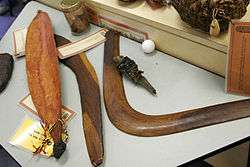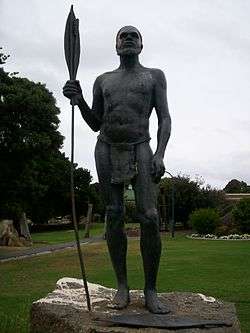Woomera (spear-thrower)
| Look up woomera in Wiktionary, the free dictionary. |


A woomera is a wooden Australian Aboriginal spear-throwing device.[1][2][3] Similar to an atlatl, it is an extension of the human arm that enables a spear to travel at a greater speed and force than possible with the unaided arm. The town of Woomera in South Australia, founded in 1947 as the home of the Anglo-Australian Long Range Weapons Establishment, is named after the spear thrower.
Description
The woomera is 2 to 3 feet (61 to 91 cm) in length.[4] One end is 3 inches (8 cm) wide and possessing a hollow, curved cross-section not unlike an airfoil, while the other is more pointed and has a hook. The woomera was traditionally decorated with incised or painted designs that indicated belonging to a particular linguistic group that it may be returned to if found abandoned.
Use
Records show that the implement began to be used about 5000 years ago.[5] It is still used today in some remote areas of Australia. Like spears and boomerangs, woomeras were traditionally used only by men. Some woomeras, especially those used in the central and western Australian deserts,[6] were multi-purpose tools.[7] Often shaped like long narrow bowls, they could be used for carrying water-soaked vegetable matter (which would not spill and could later be sucked for its moisture) as well as small food items such as little lizards or seeds. Many woomeras had a sharp stone cutting edge attached to the end of the handle with black gum from the triodia plant. This sharp tool had many uses, such as cutting up game or other food and wood. It is supposed that the woomera could be used as a shield for protection against spears and boomerangs. The woomera is held in one hand while the other hand places the butt of the spear on the woomera's hook; the hollow curved shape facilitates this alignment without looking. The woomera doubles the length of the thrower's arm, greatly increasing the velocity of the spear. Correcting for the game animal's lateral dodging is accomplished by tilting the wing-shape woomera during the throw for last-second corrections. The extra energy gained from the woomera's use has been calculated as four times that from a compound bow.[5]
References
- ↑ Phyllis Mary Kaberry -Aboriginal woman, sacred and profane 1970- Page 14 "The Aborigines generally use a spear-thrower (noslal) and a shovel-spear (djinad), the fashioning of which is a long and delicate process. The blade made of iron, mudagandji, must be welded into an oval shape varying from three to five ..."
- ↑ Mitchell Rolls, Murray Johnson -Historical Dictionary of Australian Aborigines 2010- Page 157 "SPEAR-THROWER. A wooden implement that has a projection peg either carved into or secured to the butt, the spear-thrower greatly increased the range and accuracy of spears hurled by Aboriginal hunters. It could also be used for a ..."
- ↑ Linley Erin Hall The Laws of Motion: An Anthology Of Current Thought- 2005 - Page 66 -" In Australia the spear thrower is popularly called a woomera, one of the many Aboriginal names for a spear thrower"
- ↑ Earp, G. Butler (1852). The Gold Colonies of Australia. London: Geo. Routledge & Co. p. 126.
- 1 2 "Extinction's group theory". The Sydney Morning Herald. Fairfax Media. 25 June 2004. Retrieved 21 October 2011.
- ↑ Gould, Richard A. (Richard Allan) (1970). Spears and spear throwers of the Western Desert Aborigines of Australia. American Museum of Natural History, New York
- ↑ Cundy, B. J. (1989). Formal variation in Australian spear and spearthrower technology (Vol. 546). British Archaeological Reports Ltd. Chicago
External links
- Aboriginal technology
- A drawing of a woomera, from the book Boy Scouts Beyond the Seas: "My World Tour" by Sir Robert Baden-Powell, 1913